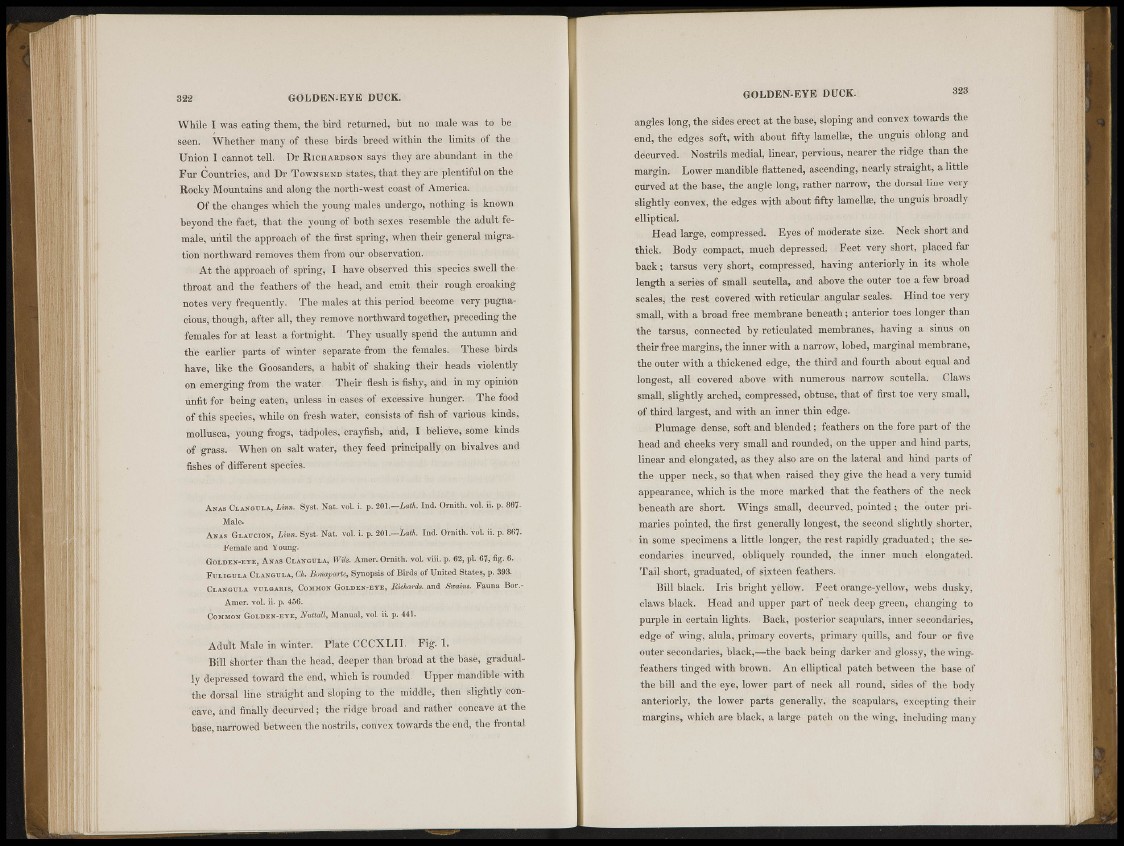
322 «OLDKN.KYK DUCK.
While I was eating themy the fed returned, but no male was to be
seen. Whether many of these birds breed within the limits df the.
Union I cannot tell. Dr Richardson says they i r e abundant; in the
Fur ©Mintries, and Dr Townsene étatesythat they ai-e plentiful on the
Rocky Mountains and along the north-wesUefoast. of" America.
Of the changes which the young males undergo, nothing is, known
beyond the fact, that the young of both sexes fcesenible the adult female,
until the approach of the first spring, when their general migration
northward remores them frtini our observation.:
At the approach of spring, I have observed this species swell thethroat
and the feathers of-'tho head; and emit, ¡their rough croaking
notes very frequently. The males at this period become -pugnacious,
though, after all, they remove northward together, preceding the
females for at least a fortnight. The.y usually sperid the autumn and
the earlier parts of winter separate from the females, These birds
hare; like the Goosanders, » habit of shaking their heads -violently
on emerging from the water. Their iles-h is ifisKy, and in mv opinion
unfit for being 'oaten, unless in'Cases of excessive hunger.. The food
of this species, while on fresh water, consists 'of fish of various kinds,
mollusca, young frogs, tadpoles, crayfish, aid, I bMieteysoine kinds
of grass. When on salt water, they feed principally on bivalves and
fishes of different species.
Anas Ciasubla, IAm.i. Syst. Nat. Vfllí i, p. 201,—íatfi. Ini áímiíi, vol. ii, j . 887.
Mal<v
Asís fiiiuciós, Eii». Syst. Nat. vol. l. p. 20&ZÓ&. InS. Oroiith. vol. ii, p. 867.
Female awl Youi%. •
(¡olmek-kyk, Amas CiavgcÍa, WA. Amer. Omith. vol viii. p. 82, pi. 67, tig. fi.
Fuligtjla Ci.axgi:i.a, Í.V.. Ili.ntti.nrtc, Synopsis ot'liinis or' United:States, p. 393.
Clangula vulgaris, Common Góídén-eye, BÁckardx. and Strains. Fauna Bor.-
Amer. vol. ii, p. 456.
Common Golden-eve, Xittta-'l. Manual, vol. ii p. 441.
Adult Male in winter. 1'Tate CCCXI.II. Kg. I.
Bill shorter than the head, deeper than br'oad at the basé, gradually
dejíSkéd toward the ciid, which'is rounded. Upper mandible with
the dorsal line straight and sloping to the middle, then slightly iefflte-
' cave, and finally decurved; the ridge broad and rathe r cohcave at the
base, narrowed betweéá the nostrils, convex towards the end, the frontal
GOLDEN-EYE DUCK. 323
angles long, the sides erect at the base; sloping and convex towards the
end, the edges soft, with about fifty lamelte, the unguis oblong and
décurved. Nostrils medial, linear, pervious, nearer the ridge than the
margin. Lower mandible flattened, ascending, nearly straight, a little
curved at the base, the angle long, rather narrow^ the dorsal line very
slightly convex, the edges with about fifty lamellae, the unguis broadly
elliptical.
Head large, compressed. Ky«s of moderate size. Neck short and
thick. Body compact, much depressed!: Feet very short, placed far
back; tarsus very short, compressed, having anteriorly in its whole
length a series of small seutella,, and above the outer toe a few broad
scales; the rest; covered with reticular.angular scales. Hind toe very
small, with a broad free membrane beneath; anterior toes longer than
the tarsus, connected by reticulated membranes, having a sinus on
their free margins, thte inner with a narrow, lobed, marginal membrane,
the Outer with a thickened edge, the third and fourth about equal and
longest, all covered above with numerous narrow seutella: Claws
small, slightly arched; compressed, obtuse,, that of first toe very small,
<jf third largest, and with an inner thin edge-
Plumage dense, soft and blended ; feathers on the fore part of the
head and cheeks very small and rounded, on the upper and hind parts,
linear and elongated, as they jlso are on the lateral and hind parts of
the upper neck, ;seï that when raised they give the head a very tumid
appearance, which is the more marked that the feathers of the neck
beneath are short. Wings small, decurved, pointed ; the outer primaries
pointed, the first generally longest, the second .slightly shorter,
in some specimens a little longer, the rest rapidly graduated ; the secondaries
incurved, obliquely rounded, the inner much elongated.
Tail short, graduated, of sixteen feathers,
BijiMack. Iris bright yellow. Feet orange-yellow, webs dusky,
claws black. Head and upper part of neck deep green, changing to
purple in certain lights. Back, posterior scapulars, inner secondaries,
edge of wing, alula; primary coverts, primary quills, and four or five
outer secondaries, black,—the back being darker and glossy, the wingfeathers
tinged with brown. An elliptical patch between the base of
the hill and the eye, lower part of neck all round, sides of the body
anteriorly, the lower parts generally, the Scapulars, excepting their
margins,, which are black, a large patch on the wing, including many